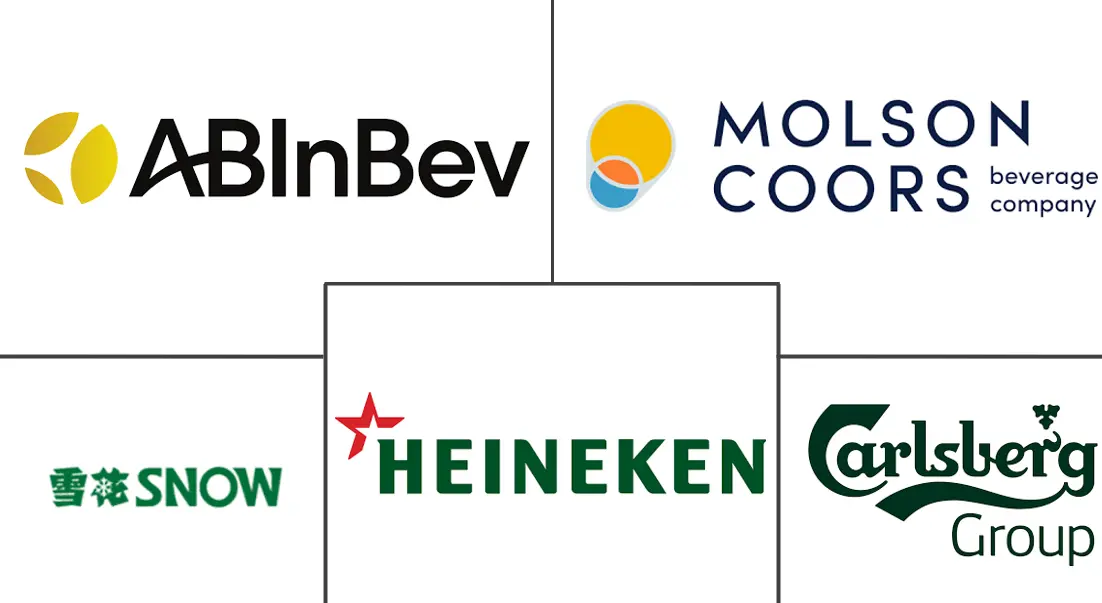Lager Market Size and Share
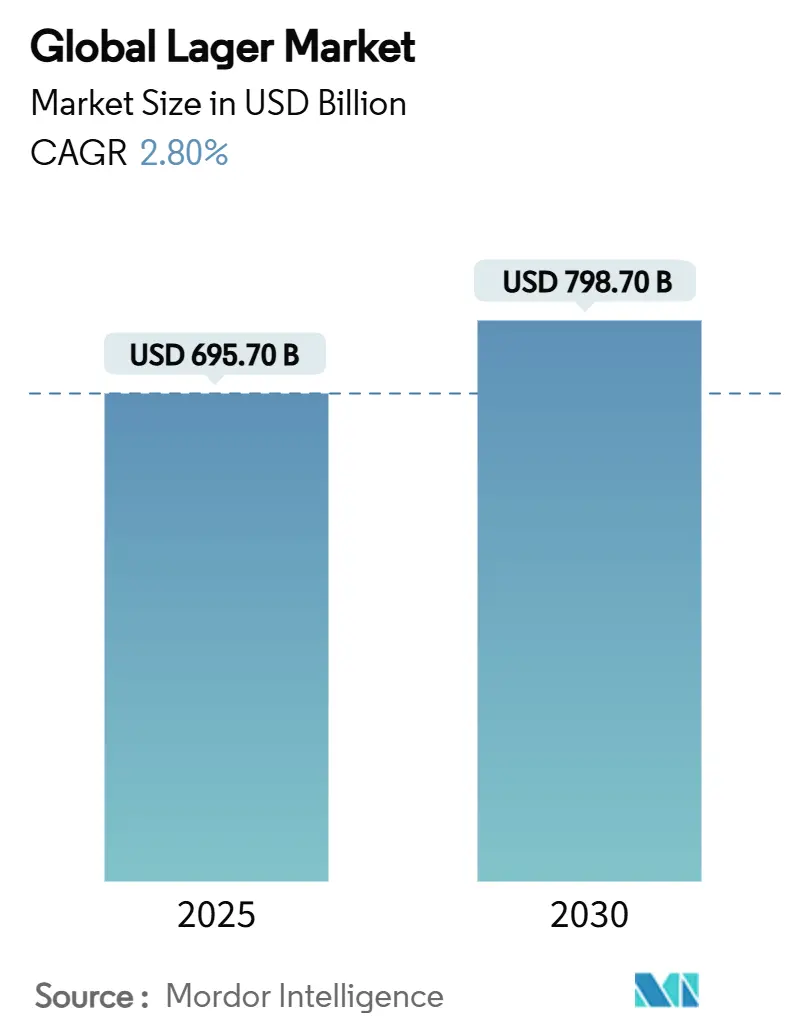
Lager Market Analysis by Mordor Intelligence
By 2030, the global lager market size, valued at USD 695.70 billion in 2025, is projected to grow to USD 798.70 billion, marking a CAGR of 2.80%. Driven by shifting consumer preferences, technological innovations, and broader market access, the demand for lager is surging. Responding to health trends, consumers are gravitating towards lighter, low-calorie, and low-alcohol lagers. This shift has led breweries, like Great Lakes Brewing, to debut wellness-centric products, exemplified by their 100-calorie “Cold Rush” launched in August 2024. Meanwhile, craft breweries are pushing the envelope in the lager domain, introducing unique variations such as dark lagers and hybrid infusions, with Europe and North America leading the charge. Supporting this momentum, the Brewers Association reported 9,796 craft breweries in the U.S. in 2024, including 3,552 brewpubs and a dominant 3,936 taprooms. Furthermore, technological advancements—ranging from AI-driven brewing and eco-friendly packaging to blockchain traceability—are bolstering production efficiency and fostering consumer trust. Together, these developments highlight lagers' pivotal position in the evolving global beverage landscape.
Key Report Takeaways
- By product type, pale lager captured 74.80% of the lager market share in 2024, while dark lager is advancing at a 3.40% CAGR through 2030.
- By category, standard lager accounted for 61.30% of the lager market size in 2024, whereas premium lager is expanding at a 4.56% CAGR to 2030.
- By packaging type, glass bottles held 47.20% revenue share in 2024, but metal cans are growing at a 3.89% CAGR on sustainability and convenience gains.
- By distribution channel, on-trade commanded 37.70% value in 2024 and is growing at a 3.80% CAGR, underscoring the resilience of experiential consumption.
- By geography, Europe led with 45.60% value share in 2024, while Asia-Pacific is projected to add the most absolute value with a 5.18% CAGR through 2030.
Global Lager Market Trends and Insights
Driver Impact Analysis
| Driver | (~) % Impact on CAGR Forecast | Geographic Relevance | Impact Timeline |
|---|---|---|---|
| Growing demand for craft and premium lagers | +0.8% | Global with strength in North America and Europe | Medium term (2-4 years) |
| Expansion of microbreweries and specialty brands | +0.6% | North America, Europe, and Asia-Pacific urban centres | Long term (≥ 4 years) |
| Innovation in brewing techniques | +0.4% | Global technology leaders in Europe and North America | Long term (≥ 4 years) |
| Rising popularity of low-, no-, and gluten-free lagers | +0.7% | Global with emphasis in Europe and North America | Short term (≤ 2 years) |
| Limited-edition and hybrid lager styles | +0.3% | North America, Europe, select Asia-Pacific markets | Medium term (2-4 years) |
| Sustainable brewing practices | +0.5% | Global with regulation-driven adoption in Europe | Long term (≥ 4 years) |
| Source: Mordor Intelligence | |||
Growing demand for craft and premium lagers
Craft and premium lagers are rapidly reshaping the global lager market, catering to evolving consumer preferences and yielding higher margins for brewers. Millennials and Gen Z are drawn to distinctive, flavorful, and artisanal lagers, with a particular interest in fruit-infused, lower-alcohol, and sustainably-produced options. This trend is bolstered by government and industry initiatives, such as the UK's Drinkaware campaigns and Germany's Beer Duty Law, which offer tax incentives and champion responsible drinking, emphasizing quality over sheer volume. Breweries are responding with eco-friendly initiatives, like Carlsberg's 76% reduction in plastic through its Snap Pack, and marketing narratives that resonate with environmentally-conscious and experience-driven consumers. As demand surges, so does the production of craft lagers, signaling a robust market expansion. Noteworthy product innovations in 2024-25 further underscore this growth trajectory. For example, Revolution Brewing unveiled its all-malt "Cold Time" premium lager in February 2024, while Heineken rolled out flavored variants such as Tiger Soju in Malaysia and expanded its premium portfolio in China and India. In essence, the rising popularity of premium lagers underscores a global consumer shift towards craftsmanship, authenticity, and wellness, influencing brewing strategies and market dynamics worldwide.
Expansion of microbreweries and specialty beer brands
Microbreweries and specialty beer brands are rapidly expanding, significantly boosting the global lager market by providing consumers with localized, innovative, and experiential beer choices. The Brewers Association reported that in 2024, Vermont boasted over 15 breweries for every 100,000 residents, highlighting a commitment to local engagement and craft quality, even as the market matures[1]Brewers Association, "Craft beer breweries per capita in the United States, "www.brewersassociation.org. This trend of localized craftsmanship is evident in Australia, where Charleys Creek Brewing Co. debuted in early 2025, timing its launch with a regional Melon Fest to strengthen its community ties. Product innovation is also on the rise, drawing a broader audience into the market. BrewDog, for example, introduced its Wingman Touchdown Lager just before the 2025 Super Bowl. This limited-edition craft lager, brewed with Simcoe and Citra hops, showcases the blend of specialty beer with mainstream events. In Spain, GURES unveiled Anarchy Lager in April 2025—a wheat lager, infused with local nettles and sporting a punk-rock label—highlighting how microbreweries are tapping into local ingredients and narratives to establish unique market positions. These trends—from Europe's microbrewery surge and the U.S.'s craft density to Australia's regional brewery launches and Spain and Scotland's inventive product rollouts—underscore the global transformation of lager demand, enriched by local flavors, innovation, and community ties.
Innovation in brewing techniques
Innovative brewing techniques are reshaping the global lager market, enhancing quality, efficiency, and sustainability. Pioneering these changes, brewers like Pilsner Urquell leverage AI-driven fermentation and recipe optimization. In 2024, the industry widely adopted techniques like high-gravity brewing, cryo hops, and thiol-enhanced yeast, aiming to boost yields, enhance aroma, and minimize waste. In May 2025, Yakima Chief Hops introduced Cryo Fresh, a pelletized form of fresh-cone hops, achieved through cryogenic lupulin separation. This innovation intensifies aroma, minimizes waste, and ensures a consistent hop character, condensing the aroma of an entire barrel into just two pellet boxes. On the yeast front, 2024 saw a surge in thiol-enhanced strains. Omega Yeast’s Lunar Crush OYL-403, a “thiolized” lager yeast, featured in an October 2024 Cold IPA recipe, unlocked hop-derived thiols like citrus and guava, delivering bold tropical notes without excessive hops. Endorsements from government and industry bodies underscore these trends. The U.S. Brewers Association and EU food standards regulators are weaving technology-driven quality controls and sustainability benchmarks into licensing criteria. In 2025, EssFeed highlighted eco-friendly packaging and low-alcohol, fruit-infused lagers as top innovations, underscoring a commitment to sustainability and diverse flavors. Heineken’s Amsterdam Studio, in early 2025, rolled out pilot “wild” and lactic-fermented lagers and is investing EUR 45 million into an R&D hub, aiming to harmonize modern experimentation with traditional consistency.
Increasing popularity of low-alcohol, alcohol-free, and gluten-free lagers
As consumers increasingly prioritize health, inclusivity, and mindful drinking, the global lager market is undergoing a significant transformation, driven by the rising popularity of low-alcohol, alcohol-free, and gluten-free options. Trends emphasizing health—such as GLP‑1-driven moderation and the "sober curiosity" movement—have spurred a marked uptick in the demand for low- and no-alcohol brews. Take Michelob Ultra, for instance: its low-carb, 4.2% ABV profile witnessed a 3.1% sales boost in US stores, as drinkers gravitated towards lighter choices. Not resting on its laurels, the brand is set to unveil its Michelob Ultra Zero, boasting a 0.0% ABV, in January 2025. Concurrently, the gluten-reduced and gluten-free beer segment is witnessing a rapid expansion. A case in point: Paulaner USA introduced the Paulaner Weizen Radler 0.0% in 2024. Furthermore, EssFeed highlighted that in 2025, eco-friendly, low-alcohol lagers—especially fruit-infused and low-calorie variants—were celebrated as among the "Top 10 innovations." Regulatory bodies and associations are also playing a pivotal role. A notable example: in August 2023, the UK revamped its alcohol duty, shifting the focus from volume to strength. This change birthed a new duty band for beers capped at 3.4% ABV. By 2024, major breweries, including Heineken, Carlsberg, and Grolsch, adjusted their lagers in line with these reforms, aiming to optimize costs. Fast forward to February 2025, the UK government rolled out further tax incentives. These included an elevated draught relief and an expanded small-producer relief, which can slash duties by up to 90% for craft and low-alcohol brewers.
Restrains Impact Analysis
| Restraint | (~) % Impact on CAGR Forecast | Geographic Relevance | Impact Timeline |
|---|---|---|---|
| Increasing competition from non-alcoholic beverages | –0.9% | Global, acute in North America and Europe | Short term (≤ 2 years) |
| Heightened consumer health consciousness | –0.6% | Global with strongest effect in developed markets | Medium term (2-4 years) |
| Rising raw material costs | –0.4% | Global with supply-chain sensitivity | Short term (≤ 2 years) |
| Stringent regulatory restrictions | –0.3% | Europe, North America, selected Asia-Pacific jurisdictions | Long term (≥ 4 years) |
| Source: Mordor Intelligence | |||
Increasing competition from non-alcoholic beverages
As consumers increasingly prioritize wellness and moderation, the global lager market finds itself reshaped by rising competition from non-alcoholic beverages. Once a niche offering, the realm of non-alcoholic beer has burgeoned, now boasting a diverse array of innovations. Today's lineup features everything from craft NA lagers and hop-infused seltzers to health-centric options like prebiotic sodas and adaptogenic drinks. In 2025, Four Seasons Hotels noted a marked rise in sales of alcohol-free cocktails. Concurrently, industry giants such as AB InBev, Heineken, and Molson Coors have been aggressively bolstering their 0.0% portfolios to maintain a competitive edge. Meanwhile, companies like Poppi, which raked in over $100 million in 2024 before its acquisition by PepsiCo, are encroaching on traditional beer's territory. This shift has been further propelled by initiatives like the UK's "Drink Free Days" and the U.S. Surgeon General's 2025 advisory linking alcohol to cancer risks. Consequently, lagers now contend not just with other beer formats but with a wider beverage landscape. This ecosystem offers social and flavorful experiences, all while sidestepping the downsides of alcohol. The ramifications are evident: consumer spending has become more fragmented, brand loyalty in the beer segment has shortened, and traditional lager producers find themselves at a crossroads. They must innovate or risk obsolescence in this dynamic beverage arena.
Heightened consumer health consciousness
Drinking habits are shifting, with a noticeable tilt towards moderation and wellness-centric choices. Notably, Millennials and Gen Z are steering away from conventional beers. A recent survey in the UK highlighted this trend: over 76% of adults are consciously moderating their alcohol intake. One in three pub outings is now alcohol-free, and 34% of patrons are practicing "zebra striping," alternating between alcoholic and non-alcoholic drinks. This shift is bolstered by government and public health initiatives. For instance, England's proposed alcohol warning labels, which spotlight cancer risks, and the U.S. Surgeon General's advisory for 2025, are amplifying societal pressures to reduce alcohol consumption. Consequently, there's a marked uptick in the preference for low- and no-alcohol beers, premium mocktails, and lagers with a modest 4–5% ABV. Major brewers are taking note: Heineken expanded its Heineken 0.0 line, celebrating a 10% sales growth in 2024. Meanwhile, Michelob Ultra's emphasis on low-calorie marketing spurred a 3.1% uptick in U.S. store sales, defying the broader trend of declining beer volumes. Public health campaigns, coupled with taxes like Scotland's 50p-per-unit minimum pricing and sugary-drink levies in various U.S. cities, are further steering consumers towards these healthier, lower-ABV options. Together, these health-centric initiatives and evolving consumer preferences are slicing into the market share of traditional lagers, compelling established brewers to either innovate or risk obsolescence in this swiftly changing landscape.
Segment Analysis
By Product Type: Pale lager dominance masks dark innovation
In 2024, pale lager captured a commanding 74.80% of global revenue, thanks to its universally recognized flavor. Meanwhile, dark lager, with a 3.40% CAGR, indicates a niche audience gravitating towards its bolder profiles and craft heritage. Pale lager's dominance in the global market stems from its light, crisp flavor, widespread appeal, and broad distribution. Major brands like Budweiser, Heineken, and Carlsberg have made pale lagers the preferred choice for casual gatherings, sports events, and daily enjoyment. Their production not only benefits from economies of scale but also emphasizes sustainable practices. Notably, in 2024, Heineken rolled out Tiger Soju, a flavored pale lager, in Malaysia, while Carlsberg debuted 1664 Brut, both aligning with fresh consumer tastes. Concurrently, European breweries spotlighted energy-efficient brewing and eco-friendly packaging for their pale lagers.
On the other hand, dark lagers are emerging as the fastest-growing segment, fueled by a surging consumer appetite for full-bodied, malty, and craft-centric flavors. With their caramel undertones and richer profiles, these beers are finding favor in Europe and North America, especially during the colder months and alongside hearty meals. This rising demand is further amplified by innovative product developments. For example, Heineken's early 2024 move to broaden its black lager range in Europe resulted in a 26% uptick in engagement. Craft breweries are also riding this wave, with Carlsberg testing eco-friendly packaging for its dark beer lineup in 2024. Additionally, microbreweries are enhancing the smoothness and mouthfeel of dark lagers through nitrogen infusion. In conclusion, while pale lagers thrive on their widespread appeal and convenience, dark lagers are witnessing a surge as consumers increasingly seek depth, complexity, and premium experiences—driven by craft innovations, seasonal inclinations, and a broader market reach.
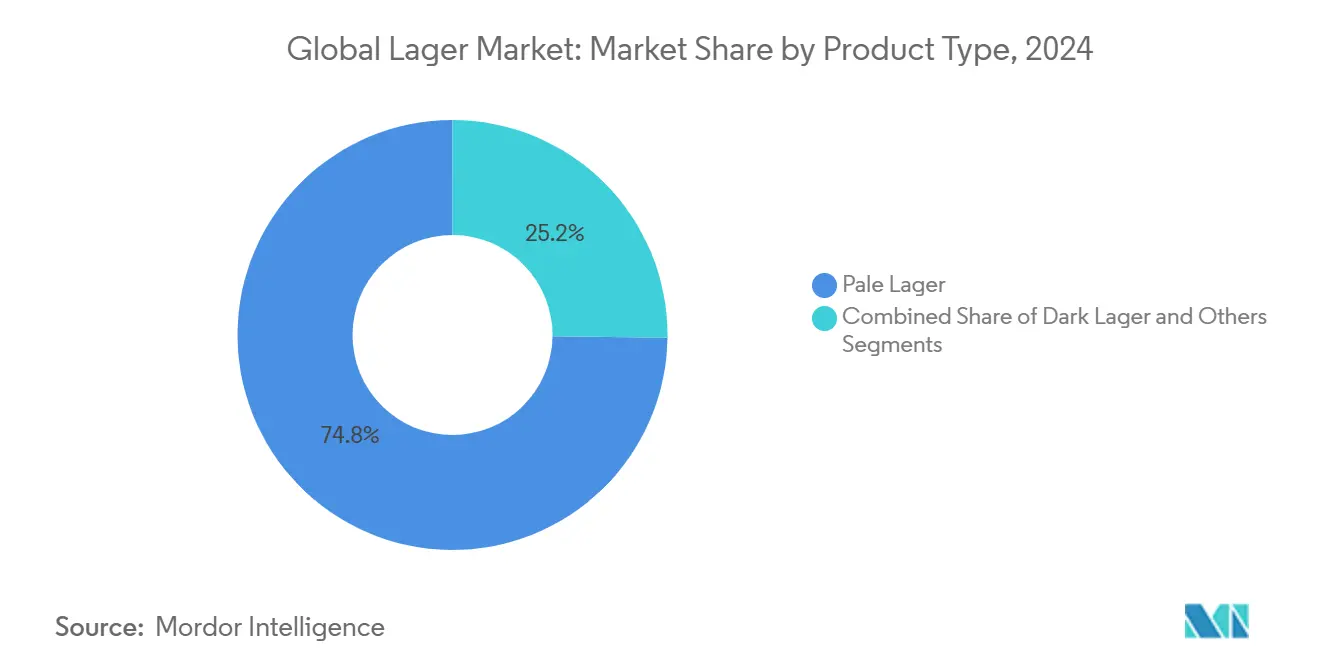
Note: Segment shares of all individual segments available upon report purchase
By Category: Premium surge validates value migration
In 2024, standard labels accounted for 61.30% of sales, offering cost-effective choices that leverage economies of scale. Premium labels, enjoying a 4.56% CAGR, emphasize ingredient quality, limited editions, and upscale branding. Standard lagers, often dubbed "regular," dominate the global scene, thanks to their universal appeal, affordability, and high-volume sales. With a light, clean profile, these beers attract a diverse audience—from supermarket patrons to pub enthusiasts—bolstered by robust distribution networks and economical brewing methods. Their mass production not only capitalizes on economies of scale but also embraces sustainability (think aluminum cans and recyclable packaging), cementing their widespread presence. This robust demand has kept lager prices accessible. For context, the Central Statistical Office of Poland reported the average price for a 0.5-liter lager in 2023 was PLN 3.84[2]Central Statistical Office of Poland, "Average retail price of bottled lager beer in Poland", stat.gov.pl.
On the other hand, premium lagers are witnessing the fastest growth. This surge is fueled by increasing disposable incomes, particularly in the Asia-Pacific region, and a shift in consumer preferences towards quality, craftsmanship, and distinct flavors, especially in bars and restaurants. These trends are further bolstered by governmental and association support: in Europe, initiatives like Germany’s Beer Duty Law provide subsidies and tax breaks to small brewers of premium lagers, while public campaigns are raising beer quality standards. In the U.S., the Brewers Association notes a rising consumer appetite for premium experiences, spotlighting West Coast IPAs and craft lagers, spurring market innovation. A case in point: Heineken's global push of Heineken Silver and its premium variants has driven a notable 9% surge in premium volume for 2024.
By Packaging Type: Sustainability drives can innovation
Glass commanded a dominant 47.20% market share, celebrated for its heritage cues and on-premise rituals. Metal cans, expanding at a 3.89% CAGR, cater to portability demands and highlight their recyclability. Standard glass-bottled lagers reign supreme in the global lager market, largely due to perceptions of premium quality, tradition, and sustainability. In Europe and North America, bars, restaurants, and craft-beer venues favor glass bottles, as their tactile and aesthetic qualities elevate the drinking experience. This tradition has garnered support from brewers and associations alike. Notably, European recycling initiatives and producers such as Vetropack, with their lightweight Echovai returnable bottle, emphasize both environmental responsibility and craft allure.
Meanwhile, canned lagers are witnessing the fastest growth. This rise in canned beer underscores a consumer shift towards convenience—valuing lightweight, portable, and shatterproof options—alongside a desire for flavor stability, safeguarded from light and oxygen. The eco-friendly nature of highly recyclable aluminum further fuels this trend, prompting manufacturers to adapt their packaging. A case in point: in November 2024, Douglas Lager, a staple from the Pacific Northwest, introduced 16‑oz cans, broadening its appeal for off-premise and outdoor settings. In conclusion, while glass bottles continue to lead with their premium and sustainable image, cans are rapidly gaining ground, driven by their convenience, flavor preservation, recycling benefits, and resonance with today's mobile lifestyles.
By Distribution Channel: On-Trade recovery defies predictions
In 2024, the on-trade sector, buoyed by a post-pandemic resurgence in social gatherings, claimed a 37.70% market share and is on track to grow at a 3.80% CAGR. Meanwhile, the off-trade sector continues to thrive, bolstered by grocery sales, e-commerce, and strategic price promotions. On-trade channels, particularly bars, pubs, and restaurants, dominate the global lager market, not only holding the largest share but also witnessing the fastest growth. These venues provide social and experiential atmospheres, enticing consumers with premium lager and craft beer selections, leading to heightened engagement and spending. This momentum is further fueled by the proliferation of microbreweries and a burgeoning consumer appetite for distinctive, locally brewed lagers, which flourish in on-premise settings. For context, the Brewers Association noted 2,092 microbreweries in the U.S. in 2023, while Brewers of Europe cited a rise to 1,710 microbreweries in the same year[3]Brewers of Europe, "Number of active beer brewing companies in the United Kingdom", www.brewersofeurope.eu.
Conversely, off-trade segments, including supermarkets and convenience stores, experience steady yet more tempered growth. Their success hinges on convenience, broader retail access, and a notable uptick in e-commerce sales. Reports from government and industry sources spanning 2024–2025 underscore innovations tailored for these channels. For instance, bars in the UK are seeing a surge in premium lagers like Madrí Excepcional, while off-trade consumers in China are being targeted with health-centric launches such as AB InBev’s Harbin Zero Sugar. In summary, while the on-trade sector's emphasis on dynamic social experiences and premium offerings fuels its rapid expansion, the off-trade sector's growth, though steadier, is anchored in accessibility and shifting consumer tastes.
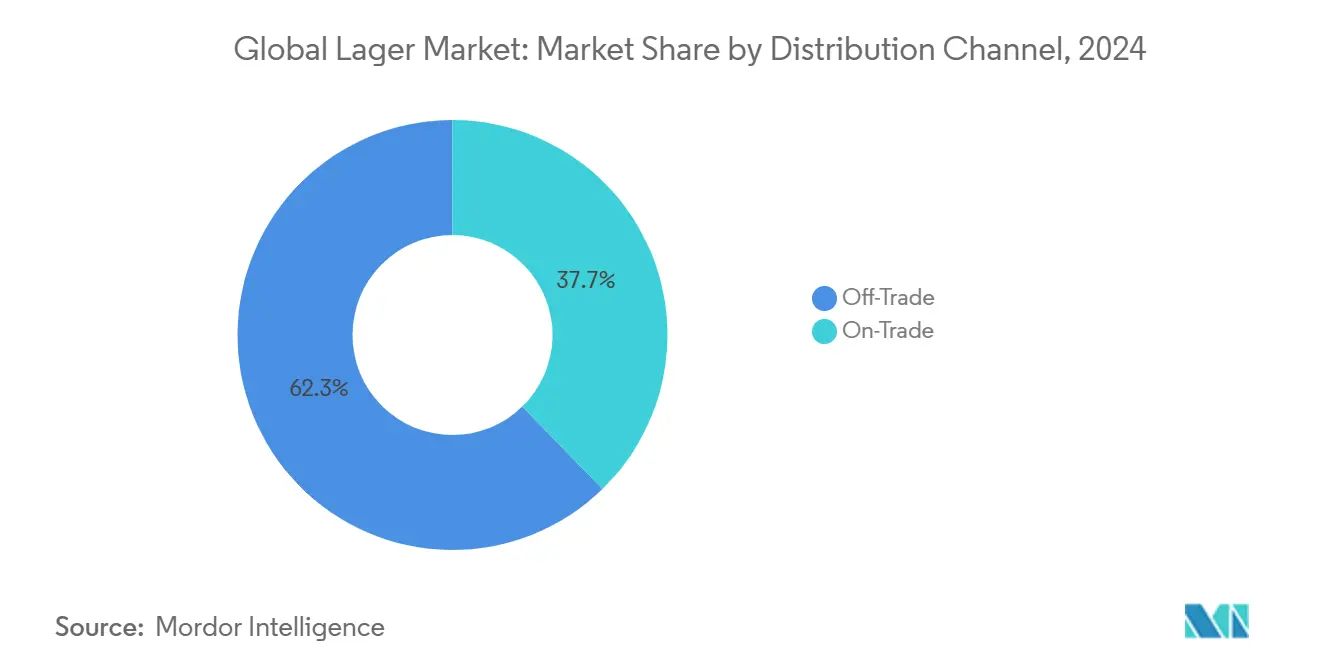
Geography Analysis
In 2024, Europe accounted for 45.60% of global sales, but its growth is hampered by an aging demographic and a shift towards wellness. Europe, with its rich brewing heritage, commands the largest share of the global lager market. This dominance is bolstered by a robust demand for both mainstream and craft lagers, and a vibrant on-trade culture, highlighted by renowned beer festivals like Oktoberfest. Such events significantly boost consumer engagement. For instance, data from the Brewers of Europe indicates that in 2023, the UK's per capita beer consumption hit 66 liters. Furthermore, initiatives like Germany’s Beer Duty Law and the UK’s Drinkaware campaigns underscore the region's commitment to quality and responsible drinking, further cementing Europe's leading position.
In contrast, the Asia-Pacific region is witnessing the fastest growth, boasting a 5.18% CAGR projected through 2030. The market is driven by increasing disposable incomes, swift urbanization, a warm climate that favors light lagers, and favorable tax policies. This is exemplified by 2024 product launches in Malaysia, such as Heineken’s Tiger Soju and Carlsberg’s 1664 Brut, both tailored to resonate with local tastes and the country's leisure culture.
North America, while experiencing steady growth, sees a consistent demand for both standard and premium lagers. However, this demand is somewhat eclipsed by a burgeoning craft beer scene and a trend towards low-ABV and non-alcoholic alternatives. Noteworthy craft innovations include Revolution Brewing’s “Cold Time” debut in 2024 and Madrí Excepcional’s expansion into the UK market.
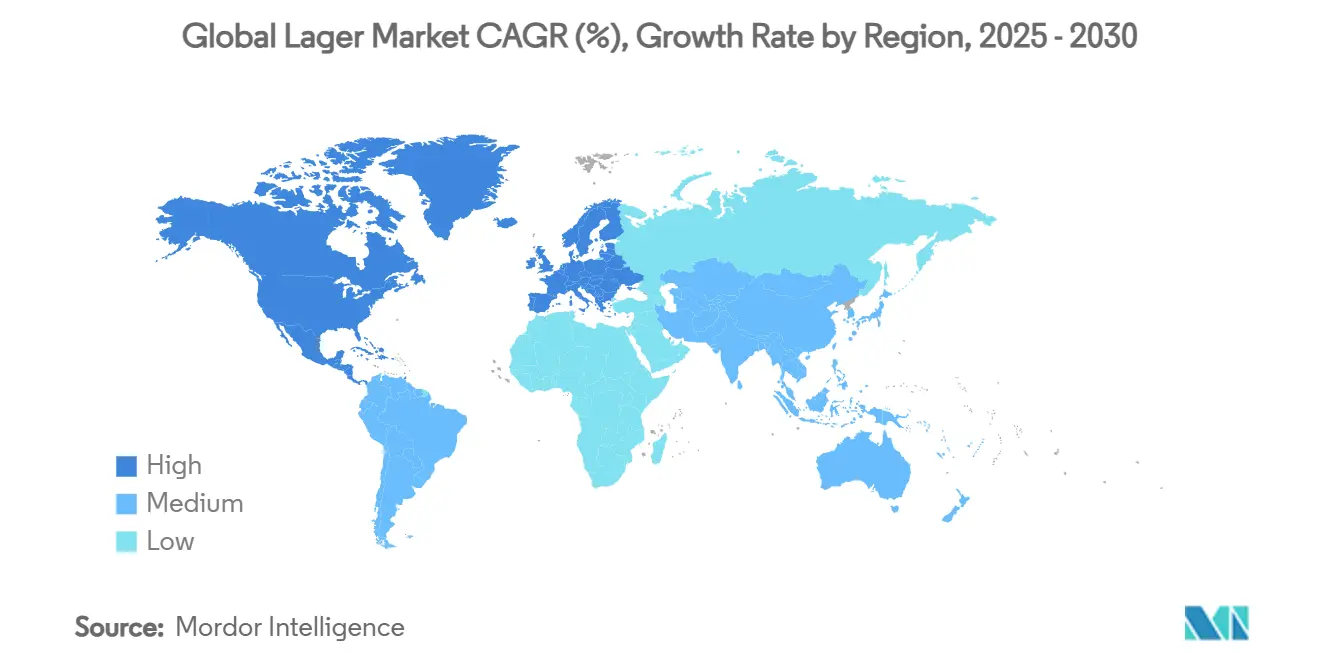
Competitive Landscape
In the global lager market, fierce competition reigns, with a few dominant brewers facing off against a surge of craft and regional players. Anheuser-Busch InBev stands at the forefront, while hundreds of smaller breweries, including Kirin, Tsingtao, Grupo Modelo, and various craft-centric regional brands, fill the landscape. These industry giants are pouring resources into product innovation, low-ABV, alcohol-free, and premium lagers. They're also adopting sustainable brewing practices, exemplified by Heineken’s initiatives in eco-friendly water usage and packaging, all in response to shifting consumer demands and regulatory pressures.
For example, in June 2025, Carlsberg Denmark unveiled Grobund, a beer crafted from 100% regeneratively grown barley malt. This initiative is the first step in Carlsberg's ambitious plan to transition all its production to regenerative grains, aiming for exclusive use by 2040. The regenerative farming methods aim to cut agricultural emissions, enhance soil health, and boost biodiversity. Additionally, the rise of digitalization, the expansion of e-commerce, and the pervasive influence of social media play pivotal roles in marketing, engaging consumers, and accessing markets.
At the same time, the market dynamics are evolving, driven by regional consolidations and partnerships. Diageo is making strides into the premium lager segment, while Carlsberg is honing in on developing markets. The craft beer movement is making waves, with microbreweries carving out niches through artisanal lager offerings and local narratives. This momentum is bolstered by supportive regulations and tax breaks, especially in Europe and North America. Consequently, the competition is a dance between scale and specialization: global behemoths harness economies of scale and vast distribution networks, whereas craft brewers champion innovation and premium offerings, painting a picture of a complex and fiercely competitive landscape.
Lager Industry Leaders
-
Anheuser-Busch InBev SA/NV
-
Heineken N.V.
-
Carlsberg Group
-
Molson Coors Beverage Company
-
China Resources Snow Breweries Ltd
- *Disclaimer: Major Players sorted in no particular order
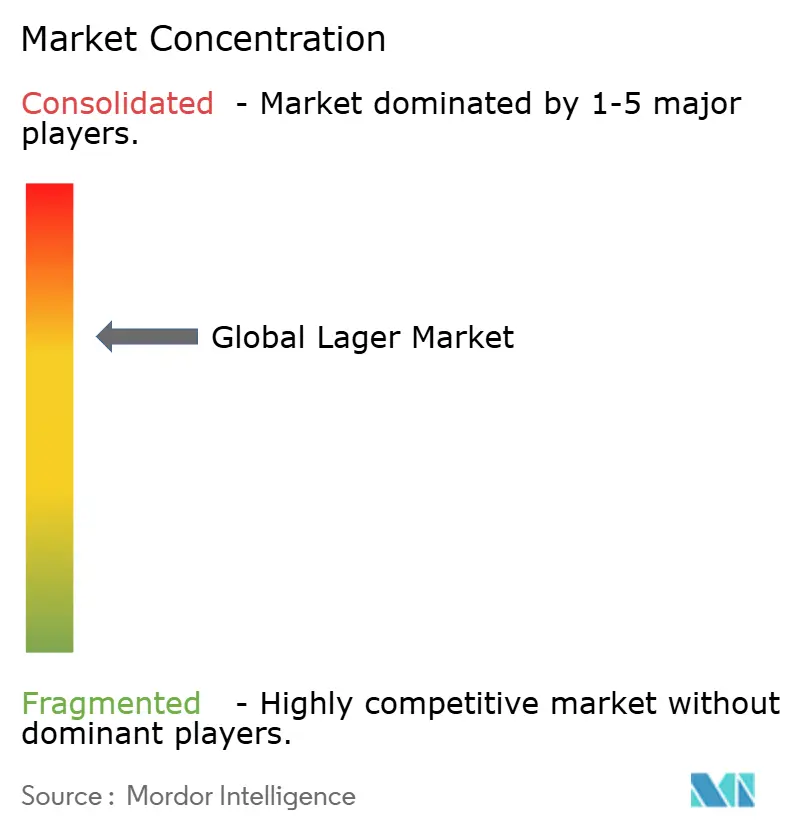
Recent Industry Developments
- February 2025: BrewDog Wingman touchdown lager was launched, which was asserted to be crafted with Simcoe and Citra hops to deliver a crisp, citrusy 4.8% ABV. This seasonal lager was released in special NFL-themed cans for Super Bowl LIX. Its limited-edition nature and bold branding underscore the synergy between beverage launches and major cultural events.
- November 2024: Wrexham Lager Beer Co. launched its product in the United States. Specifically, the beer is now available at Total Wine & More stores in 29 states. This marks the first time Wrexham Lager has been sold in the US.
- September 2024: Harpoon x L.L.Bean partnered and launched Harvest Lager, which featured Maine-grown malt and reflected outdoor lifestyle branding. Available in 16‑oz cans and packs, it launched alongside Fall Mix Packs, demonstrating how partnerships drive thematic product launches.
- August 2024: Tilray Brands acquired four craft breweries from Molson Coors, lifting output beyond 1 million barrels. The agreement will see Tilray adding Hop Valley Brewing Co., Terrapin Beer Co., Revolver Brewing, and Atwater Brewery to its portfolio.
Global Lager Market Report Scope
| Pale Lager |
| Dark Lager |
| Other Product Types |
| Standard Lager |
| Premium Lager |
| Luxury Lager |
| Glass Bottle |
| Metal Cans |
| Other Packaging types |
| On-Trade |
| Off-Trade |
| North America | United States |
| Canada | |
| Mexico | |
| Rest of North America | |
| South America | Brazil |
| Argentina | |
| Rest of South America | |
| Europe | United Kingdom |
| Germany | |
| France | |
| Italy | |
| Spain | |
| Netherlands | |
| Sweden | |
| Poland | |
| Belgium | |
| Rest of Europe | |
| Asia-Pacific | China |
| Japan | |
| India | |
| South Korea | |
| Australia | |
| New Zealand | |
| Rest of Asia-Pacific | |
| Middle East and Africa | Middle East |
| Africa |
| By Product Type | Pale Lager | |
| Dark Lager | ||
| Other Product Types | ||
| By Category | Standard Lager | |
| Premium Lager | ||
| Luxury Lager | ||
| By Packaging Type | Glass Bottle | |
| Metal Cans | ||
| Other Packaging types | ||
| By Distribution Channel | On-Trade | |
| Off-Trade | ||
| By Geography | North America | United States |
| Canada | ||
| Mexico | ||
| Rest of North America | ||
| South America | Brazil | |
| Argentina | ||
| Rest of South America | ||
| Europe | United Kingdom | |
| Germany | ||
| France | ||
| Italy | ||
| Spain | ||
| Netherlands | ||
| Sweden | ||
| Poland | ||
| Belgium | ||
| Rest of Europe | ||
| Asia-Pacific | China | |
| Japan | ||
| India | ||
| South Korea | ||
| Australia | ||
| New Zealand | ||
| Rest of Asia-Pacific | ||
| Middle East and Africa | Middle East | |
| Africa | ||
Key Questions Answered in the Report
What is the current value of the global lager market?
The global lager market is valued at USD 695.70 billion in 2025 and is projected to reach USD 798.70 billion by 2030.
Which region holds the largest share of lager sales?
Europe leads with 45.60% of global sales in 2024, reflecting long-established consumption and premium positioning.
Why are metal cans gaining ground over glass bottles?
Metal cans combine high recyclability with portability and have achieved a 3.89% CAGR, appealing to eco-conscious and on-the-go consumers.
How fast is premium lager growing compared with standard lager?
Premium lager is expanding at a 4.56% CAGR to 2030, while standard lager remains the volume anchor with 61.30% share in 2024.
What is driving growth in the Asia-Pacific lager market?
Urbanization, rising disposable income, and the premiumization trend are pushing Asia-Pacific toward a 5.18% CAGR through 2030.
How concentrated is the competitive landscape?
The top five brewers control more than 80% of global volume, underscoring high concentration and a score of 8 on a 1–10 scale.
Page last updated on:
